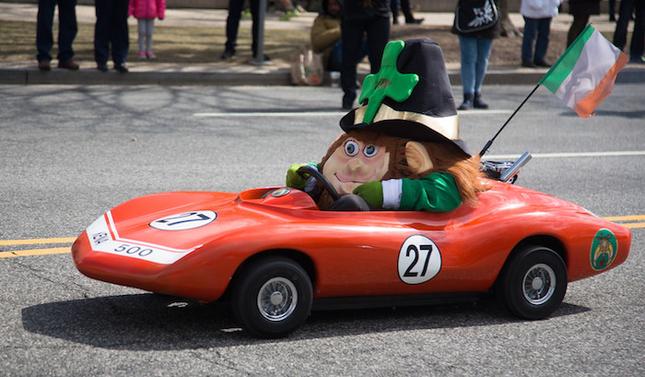On This St. Paddy’s Day, Celebrate Words, Songs and Say a Prayer, Too
By • April 23, 2015 0 870

These days, St. Patrick’s Day, the American national holiday saluting this country’s Irish heritage, which holds multitudes, sneaks up on you.
There was and will be a parade, and there will be green beer and Guinness, in all the establishments calling themselves worthily or not Irish, and there will be singing and beer on the floor and bragging and the telling of tales, perhaps. It’s the cliché of it all.
Someone somewhere, whole slew of somebodies are reading one by one out loud “Ulysses” and the lads will be hoping that there’ll be a lass, like Molly in that same book saying “yes, yes, yes.”
But there is something about the Irish worth celebrating, and it has less to do with froth on a glass, than it does the way the Irish have made their presence felt in the world, here, for certain, aye, but also elsewhere wherever they showed up in numbers.
Our histories—that sea of Americans different from one another and the same—are intertwined, beginning with early immigrants and landowners, going on to the flood of migrants in the wake of the mighty, blighted potato famine which brought a flood of the Irish to these shores, some of them just in time for the Civil War.
There is something about the Irish—they came from a country beautiful, but hard in giving out its natural wealth. They come from a country full of tillers and priests and nuns and publicans and teachers and politicians and rebels and thinkers, and the men and women of words, words, words, and actors, poets and playwrights and the mighty mothers of them all.
Getting older makes wretched excesses of Irishism less appealing, but the song on songs linger, and the words remain strongly spoken and go on being written. I remember the celebrants, too: once, I went to a St. Patrick’s Day bar in San Francisco accompanied by a young lady named Margie O’Clair, black of hair and smart of whip-like wit and beauty, too. She asked me why I wore an orange jacket to an Irish bar and proceeded to tell me why I shouldn’t have. And yet, I survived, because the Irish, I guess, can tolerate a German’s stupidity. [Editor’s note: orange is the color for Irish Protestants, who also have been called Orangemen.]
In years gone by, I knew the local places here—some still surviving—the Dubliner and Kelly’s Irish Times, cheek to cheek near Union Station, Danny Coleman and Hugh Kelly, proprietors, respectively, and I heard a gentleman from the Irish Embassy, at three in the wee morning sing “Danny Boy” in the kitchen of the Irish times., red faced and white haired and in fine voice as he was.
Here in Washington, we always tell the tales of the Kennedys, the brothers, John, Robert and Ted, the father Joe, and the mother Rose, and the not-so-holy ghosts of their stories. Boston, no matter who lives there will always be an urban shrine to the Irish.
Washington always had a lively Irish music scene, and in the 1980s, there was the Irish Tradition, the closest thing to local Irish rock stars, with accordionist Billy McComiskey, guitarist Andy O’Brien and champion Irish fiddler Brendan Mulvihill, singing “The Wild Rover” in the Dubliner and Times.
It’s the music and the poets that survive and count for so much. The Chieftains were just in time, and the plays and playwrights always are—George Bernard Shaw, the greatest and smartest wit that ever lived, Oscar Wilde, the most sophisticated man who came to such a sad end, Brendan Behan, Samuel Beckett and a whole new generation of Irish Playwrights. And let me just list: Joyce Himself and Flann O’Brien and Yeats and Seamus Heaney and the American Eugene O’Neill.
In the wiki wonderland, there is a category called “List of Irish People”. Not all, but it seems so. And the longest list are made up of writers, actors and musicians, not generals or Wall Streeters. To with: actors: Stephen Boyd, Kenneth Branagh,Pierce Brosnan, Gabriel Byrne, a number of Cusacks, including Sinead, wife to Peter O’Toole, Daniel Day Lewis, Colin Farrell, Barry Fitzgerald, whose horse knew the way in “The Quiet Man”, Fionnula Flanagan (ah, what a name), several Gleesons, including Brendan, Richard Harris, Micheal Mac Liammhoir (co-founder of the Gate Theatre), Colm Meaney, Jonathan Rhys Meyers, Liam Neeson, Maureen O’Hara, Milo O’Shea, Niall Toibin, Fiona Shaw.
Towith: musicians: Chloe Agnew, Big Tom Of big Tom and the Mainliners, Enya, Sinead O’Connor, Vivian Campbell of Def Leppard, Liam, , Paddy, Tom and Willie Clancy, The Corrs, The Edge, Seamus Ennis , Uilleann piper, Angela Feeny opera singer, Rory Gallagher, blues/rock guitarist, and I could go on, but here’s one that sums it up: Finbart Furey, singer/songwriter, uillean piper, 5 string banjo player and actor.
Towith: writers: John Banville, Brendan Behan, Maeve Binchy, Patrick Bronte, Brian Coffey, Roddy Doyle, several Delaneys, Thomas Flanagan, Brien Friel, F. Scott Fitzgerald (says so here), Oliver Goldsmith, Seamus Heaney, James Joyce, Patrick Kavanagh, Benedict Akiel (Saoi of Aosdana) C.S. Lewis, Malachi Martin, horror writer, Frank McCourt, poet Nuala Nik Dhomhnaill, the glorious O’s, Edna O’Brien, Sean O’Casey, Frank O’Connor, Mairtin O Direain, Sean O’Faolain, George Bernard Shaw, Laurence Sterne, Bram Stoker, horror writer, John Millington Synge, Twenty Major, blogger, Oscar Wilde. And so on.
So many words, so many characters, so many songs.
So, I would suggest what we can all do for St. Patrick’s day. Say a word or two, sing a song, act a part. And, of course, say a prayer.

